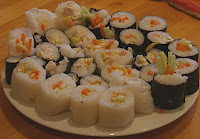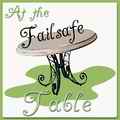Sushi Rolls
| Serves | 36 |
| Prep time | 2 hours |
| Allergy / Intolerance | Amines, Artificial Addititives, Artificial Colours, Dairy, Egg, Glutamates, Preservatives, Salicylates, Wheat |
| Suitable for | RPAH Elimination Diet - Amines Allowed, RPAH Elimination Diet - Low Chemical / Failsafe, RPAH Elimination Diet - Moderate Chemical, RPAH Elimination Diet – Very High Chemical |
| Meal type | Appetizer, Lunch, Main Dish, Savoury Snack |
| Misc | Child Friendly, Pre-preparable, Serve Cold |
| Occasion | Casual Party, Picnic, Special Occasions |
| Region | Japanese |
Easy home made sushi, with or without seaweed (nori).
Ingredients
- Bamboo sushi mat (for rolling sushi)
For the Sushi Rolls:
- 2 cups glutinous rice (sushi rice)
- 2 cups water
- 1/4 cup rice vinegar or vinegar substitute (refer to the Substitutes page for vinegar substitute)
- 2 tablespoons white sugar
- 1 teaspoon salt
- Fillings (see below)
- 6 rice paper sheets or seaweed (Nori) sheets
For the Tezu: (Optional)
- Additional rice vinegar or vinegar substitute
For the Dipping Sauce:
- 80ml water
- 1 teaspoon sunflower oil
- 1 teaspoon minced garlic
- 1 teaspoon citric acid
- 1 1/2 tablespoon soft brown sugar
Directions
| Sushi Rice | |
| 1. | Rinse the rice by placing it in a bowl, filling the bowl with enough water to cover the rice, then swishing it around, drain and repeat until the water runs clear. |
| 2. | Place the rice and water into a saucepan and let the rice soak for 20 to 30 minutes. |
| 3. | Place the saucepan onto the stove top and bring to a boil. Reduce the heat to a simmer and cover the rice. Allow to cook for 10 minutes. Turn off the heat, leave the lid on, and allow the rice to steam for 20 minutes. |
| 4. | While the rice is cooking make the sushi vinegar by mixing the vinegar, sugar and salt together in a small saucepan and heating it until the sugar and salt dissolve. |
| 5. | Once the rice is cooked, place it in a large flat bowl. Sprinkle the sushi vinegar over the rice and use a wooden spoon or spatula to mix the rice and vinegar. Try not to break or flatten the rice. |
| 6. | Once it is well mixed use a fan or plate to fan the rice down to room temperature. This will make it look glossy as well as being nice and sticky, and doesn’t take as long as it sounds. |
| While the rice is cooking prepare the fillings. Possible fillings include: | |
| 7. | Finally chopped raw vegetables – e.g. carrots (Mod Sals), celery (Low Chem), peeled cucumber (Mod Sals) - or thinly sliced cooked vegetables - e.g. sweet potato or butternut pumpkin (Mod Sals) |
| 8. | Lettuce leaves – whole leaves placed directly over the rice then other fillings added on top (Iceberg is Low Chem, other varieties contain Salicylates) |
| 9. | Mung Bean Sprouts (Low Chem) |
| 10. | Fried egg (Low Chem) – combine 1 egg, a pinch of salt, a pinch of sugar and a tblspn of water. Cook in a frying pan like an omelette, once cooked slice into thin strips. (Based on the Egg Rolls recipe in The Failsafe Cookbook.) |
| 11. | Cooked chicken mixed with cream cheese or home made mayonnaise (Low Chem) |
| 12. | Slices of tuna or salmon (tinned or cooked fillets) mixed with cream cheese or home made mayonnaise (Amines) |
| 13. | Chopped hard boiled egg (Low Chem) |
| 14. | Thinly sliced cooked chicken (Low Chem) marinated in Golden Marinade |
| Tezu | |
| 15. | Smearing Tezu over your hands helps to stop the rice sticking to them – it is incredibly sticky – but I still had to rinse my hands in water a few times. Tezu is made by mixing equal parts water and rice vinegar / vinegar substitute. |
| Making the Rolled Sushi or Futomaki (thick or fat roll) | |
| 16. | Seaweed Rolls: a) Place the seaweed sheet, shiny side down, on the bamboo mat. Place the mat so that the long side is closet to you. b) Moisten your hands with Tezu, if using. c) Spread the sushi rice evenly over the rice paper with your hands, leaving 3cm along the furthest edge of the bamboo mat bare. Make the rice about 1/2 – 1cm thick d) Place the fillings in a line along the rice about 3cm in from the nearest edge. You will need to experiment a bit with how much filling will fit. e) Starting from the nearest edge, hold the mat with both hands and roll the nearest edge over the filling, carefully squeeze and compress the mat evenly across the entire roll. Continue rolling the seaweed until the roll meets the bare edge. It should seal itself, but if it doesn’t, moisten the bare edge with a bit of water or Tezu. |
| 17. | Rice Paper Rolls: a) Soak the dry rice paper in a large bowl of warm water for about 10 seconds then place evenly over the bamboo mat. As the rice paper is round, I used the bamboo mat as the guideline for the rice and filling. Fold over the round edge closest to you so that side is straight and even with the bamboo mat. b) Moisten your hands with Tezu, if using. c) Spread the sushi rice evenly over the rice paper with your hands, leaving 3cm along the furthest edge of the bamboo mat bare. Make the rice about 1/2 – 1cm thick d) Place the fillings in a line along the rice about 3cm in from the nearest edge. You will need to experiment a bit with how much filling will fit. e) Starting from the nearest edge, hold the mat with both hands and roll the nearest edge over the filling, carefully squeeze and compress the mat evenly across the entire roll. Continue rolling the rice paper until the roll meets the bare edge. Fold the extra bit of rice paper around the roll to seal. |
| 18. | Place the rolls in the fridge for about 5 minutes before cutting them. Cut each roll in half, then each half into 3. Apparently it is bad luck to cut a roll into 4 pieces. |
| 19. | Serve straight away with the dipping sauce, or store in the fridge until ready to eat. |
| Dipping Sauce | |
| 20. | Combine all the ingredients for the dipping sauce in a small bowl. |
Note
Low Chemical /Amines, Moderate Salicylates, Glutamates – see variations and fillings.
Nori and Rice Vinegar are likely very high in glutamates, salicylates and/or amines.
This recipe made 6 large rolls, which are cut into 6 pieces each.
Variations:
- For a low chemical version use the rice paper instead of seaweed, replace the rice vinegar with vinegar substitute and use low chemical fillings.
- Another style of sushi that doesn’t use seaweed is Nigri (hand pressed sushi), which is the oval of pressed rice that often has raw fish on top, but you could also use omelette or thin strips of vegetables as the topping.
Refer here for the mayonnaise recipes and Golden Marinade recipe to use with the fillings.




 Print recipe
Print recipe

